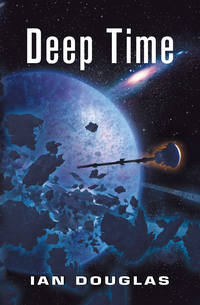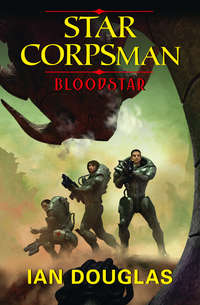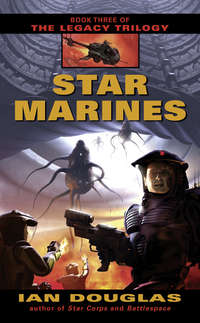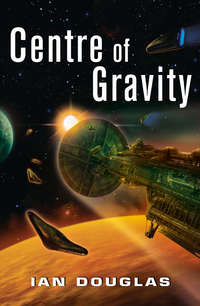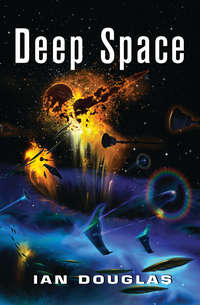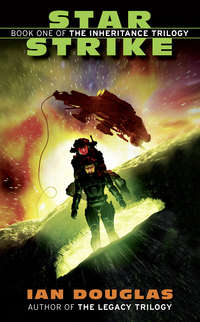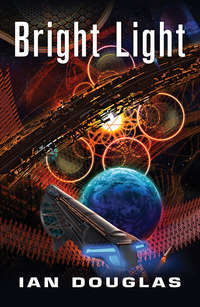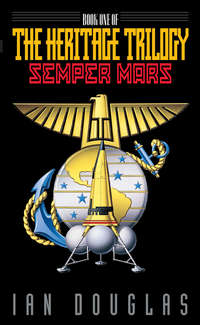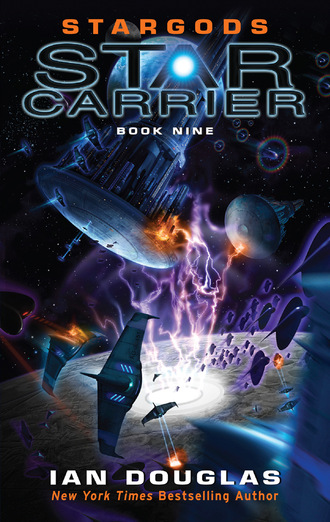
Полная версия
Stargods
Oreshkin checked his chronometer. It had been just one minute and forty seconds since Moskva had emerged from warp.
They had seven minutes, twenty seconds before the Americans would be able to see them.
USNA CVS America
Penrose TRGA
79 light years from Earth
1228 hours, FST
“This is looking like a total bust, Admiral,” Rand reported to Gray. “Four hours, and not a damned thing has come back!”
“We’ll wait a little longer, Captain,” Gray replied. But he was already pretty sure that something inside the twisted spacetime of the TRGA was terribly wrong.
The smartdrones were designed to trace out some of the open pathways within a TRGA, map them, then return to their starting point to report. Such surveys could take months, even years, because the number of paths was so high. The problem was, Gray was looking for one particular pathway that was already recorded, stretching from the Penrose TRGA and time now to the Omega Centauri Cluster TRGA. All of the drones America had launched this morning were programmed to trace out that one path, and a round trip shouldn’t have taken more than a few minutes.
The delay suggested that the globular cluster was impassable … or that the TRGA itself was not working right … or that something on the other side of Penrose was eating drones. Gray thought that last possibility the more likely. The hypernova three years earlier had devastated both the core of the N’gai Cloud and at least touched the central regions of Omega Centauri—they were, in fact, the same physical volume of space, albeit separated by almost a billion years.
Carol Conyer and others in America’s astrophysics department had assured Gray that the radiation would have died down to tolerable levels after three years—time passed at the same rate on both sides of the TRGAs—and the TRGA there ought to be safe for incoming ships.
Ought. There were a hell of a lot of unknowns in the equation.
And what if the Sh’daar themselves had posted robotic sentinels to pick off drones as they emerged from elsewhere? It was possible. After their spectacular attack on the Rosette Consciousness, they might not be feeling particularly sociable right now. The possibility that the Consciousness was alive and out for revenge must be preying on the minds of the N’gai Refusers.
“Admiral?” Rand said. The captain was standing next to the sensor display suite on the main bridge.
“Whatcha got, Captain?”
“A ship coming out of Alcubierre Drive. Ten light-minutes astern.”
Gray glanced at the chronometer: 1232 hours. “Can you make them?”
“At this distance … no, sir. But it’s big. I’d like to sound general quarters, just as a precaution.”
“Absolutely.” Until they knew what that vessel was—who was running it, and why they were out here at the Penrose gate—it would be a good idea to be prepared. The chances that two ships should show up at a TRGA at almost the same time was … remote.
The alarm klaxon went off, bringing America to full readiness. Gray stared at the sensor data on the flag bridge repeater, trying by sheer force of will to drag more information from the screen. That ship out there was big … over half a million tons, at least, which put it roughly in America’s class. And it was probably human. The drive signature matched most human FTL drives more closely than it matched any of the alien signals recorded in the ship’s sensor library.
“I’m getting additional targets out there, sir,” Lieutenant Brandon Vasquez, the sensor officer, reported. “We may be looking at a carrier dropping fighters.”
“Very well.” Gray was thinking with furious speed. The squadron might very well be under attack, though they had no way of knowing who was attacking or why. Standard tactical doctrine dictated that America launch her fighters. When the attacking vessels reached the America, enough fighters would be in space to throw a serious wrench into the enemy’s planned tactics. At the same time, the escorting vessels, Arlington, Birmingham, and Seare, would take up screening positions to protect the carrier, blocking the enemy’s approach.
But it would take time to launch the fighters. America currently had two squadrons on ready-five, meaning it would take just five minutes to get them out into space … but if those strangers out there were deploying for an assault, they would arrive when America’s fighters were still launching. They’d not put up a combat space patrol because there’d simply been no need for it, and they would have had to recover the fighters before proceeding through the TRGA.
There was a need for it now.
“Unknown fighters are accelerating, Admiral,” Vasquez announced. “Blue doppler! And … into the ultraviolet!”
The blue and UV shift meant they were accelerating all out, the light he was seeing shifted by their velocity to the blue end of the spectrum. Fighters could manage gravitational accelerations so high they could nudge the speed of light in just under ten minutes. However, Gray thought it unlikely that these would come zipping past his squadron at c, because they would be blazing in too fast to do very much at all. More likely was that they would accelerate for half the distance, or a little more, then decelerate to kill their velocity.
So … allowing for the time lag, those fighters had begun accelerating ten minutes ago. If they came past at c, they would be here any second now. But if, as was far more likely, they pulled a mid-course deceleration … well … make it eight to ten more minutes before they arrived.
That gave the USNA squadron a little—a very little—time to prepare for the assault.
“Are you tracking them now?” he asked.
“Just barely, sir,” Vasquez replied. “They’re masked by their grav projectors. But we can see them.”
Of course. Gray had taken advantage of that effect himself more than once, back when he’d been a Starhawk driver. The drive field projected ahead of a fighter severely warped local spacetime, making tracking the craft from ahead extremely difficult. But at least America’s sensors should be able to keep a lock on the enemy ship’s mass.
“CAG!” Gray ordered. “Launch your ready-fives! And put three more squadrons on ready status.”
“Aye, aye, Admiral.”
“Captain, I’d be obliged if you would position the ship in front of the TRGA opening … make it, oh, say ten kilometers from it. I want us to be ready to thread the needle when the time comes.”
“Yes, sir.”
“Lieutenant West!”
Janice “Wild” West was the flag bridge communications officer, in charge of keeping the tiny squadron connected and in touch. “Yes, Admiral!”
“Give me a channel to Captain Ferguson.”
“Right away, Admiral.”
James Ferguson was the skipper of the T-AOE fast supply vessel Acadia. His voice came through within Gray’s in-head a moment later as West opened the channel. “Yes, Admiral?”
“I’ve got a special mission for you, James.”
“You’ve got my full attention, Admiral.”
“Yeah, well … I don’t think you’re going to like this.” Gray then explained what he had in mind.
He heard Ferguson’s whistle of surprise when he’d finished. “Yessir, we can do that. But …”
“I know it’s nuts.”
“That doesn’t begin to cover it, Admiral. I do see how you got your handle, though.”
“Get on it, Captain. Time is critical.” He thoughtclicked to another link. “Lieutenant West? Let me talk to Birmingham, Arlington, and Seare.”
“Aye, sir.”
The captains of the three fleet escorts checked in—Captains Roberts, Chavez, and Messinger. “Formation Delta,” he told them. “When the bad guys come past, I want you to hit them with all we’ve got—HELs, pee-beeps, and AMSOs. We’ll accelerate for the TRGA as soon as we know we’ve blunted the assault.”
The replies came back stacked on top of one another.
“Copy that.”
“Right.”
“Aye, aye, Admiral.”
“And when I give the order to move,” Gray continued, “then move. Follow the America through the triggah right on her coattails!”
“Admiral!” That was Rand. “Missiles! We have KK missile launch from the fighters! Speed of approach … point eight-three c!”
“Confirm that!”
“Confirmed, Admiral! KKs on the way in! Impact in … I make it three minutes seventeen!”
And that was the final confirmation he needed. Up until that point, it was at least possible that the unknown ships out there were simply trying to catch up with America. Maybe they intended to deliver an ultimatum—don’t enter the TRGA or else!
But the missiles made that unlikely. “KK” stood for kinetic kill. The missiles weren’t nukes, but they were coming straight for the USNA squadron at better than three quarters of the speed of light. Anything they hit at that velocity would be transformed in a literal flash into hot plasma and hard radiation.
“Right, everybody,” he transmitted. “We have confirmed KK warshots inbound. Everybody who can do so, lay down a pattern of AMSO rounds. Let’s stop those things before they get too close!”
AMSO stood for Anti-Missile Shield Ordnance and referred to AS-78 or the newer AS-90 sandcaster missiles, projectiles capable of some thousands of Gs of acceleration loaded with tiny lead spherules that could be fired into space like shotgun blasts. Gray’s successful use of sandcaster rounds in a battle a couple of decades ago had earned him the moniker “Sandy,” a handle he was quite proud of.
The question was whether his people could lay down enough expanding cone-patterns of AMSO sand to intercept those inbound rounds. Was there anything he was missing? He thought he’d covered it all. He hadn’t wanted to fight in the first place, but the oncoming ships weren’t going to give him an option.
One minute left. Birmingham, Arlington, and Seare were loosing volley after volley of AMSO rounds, targeting the volume of space directly in front of the oncoming ships and KK missiles. The Acadia waited until the wall of shield missiles was past, then accelerated in the same direction, headed directly for the oncoming ships. Gray wanted to call Ferguson again, wanted to tell him not to cut things too close, but James Ferguson was skilled and experienced. He knew what he was doing and would look after his ship.
The remaining seconds dwindled away, a relentless countdown.
An instant before zero, a bright flash strobed in the darkness, eye-searingly savage. The first flash was followed by a second … a third …
Several hundred kilometers out there in the dark, high-velocity clouds of AMSO sand were slamming into incoming KK rounds at relativistic velocities, each impact the equivalent of some hundreds or even thousands of tons of high explosives. In moments, dozens of flashes silently flared, then dimmed across the dark and empty sky.
The scattering of flashes died away. Seconds later, surviving KK rounds began arrowing past and through the USNA squadron.
Those rounds weren’t aimed, of course. There was no way to accurately aim a weapon at a pinpoint target from ten light-minutes away. But there were so many of them, launched in a tightly packed cloud, that a few were sure to hit simply and purely by chance.
The Seare shuddered violently and slewed to port, a dazzling pulse of light erupting from her stern, and Gray’s heart sank. Damn! Ruler-straight threads of raw light streaked past the America from the detonation aft—fragments of impactors converted in an instant to lines of fast-moving plasma. Had the destroyer not intercepted that warhead, Gray knew, it would have slammed into America’s stern at eighty percent of the speed of light.
Four hundred seventy-one men and women had just died to protect the far larger carrier.
“Watch that wreckage!” Rand snapped. The mass of wreckage was tumbling now, spilling fragments in a silvery arc as it turned. Parts of her central spine were crumpling as Gray watched; Seare and the other ships of the USNA squadron were powered by tiny singularities—artificial black holes—and the destroyer’s power tap singularities didn’t simply go away when the ship was destroyed. They were moving through the wreckage’s center of mass now, feeding greedily on the debris.
“Maneuvering, Captain,” the helm officer reported. America was using some of her reaction mass to nudge the massive star carrier to the side, avoiding the spill of wreckage. America had magnetic screens in place, of course—hull-conforming shielding designed to protect her from radiation and relativistic impacts at near-c velocities—but the largest pieces were too massive and could cause serious damage to America’s aft hull if they struck.
Some hundreds of kilometers aft, the Acadia was weathering a storm of missiles. A KK projectile grazed her forward shield cap, the flash loosing a geyser of water freezing instantly to sparkling particles of ice. “Took a hit there, America,” Captain Ferguson said over the open channel. “Nothing major. Cargo hatches are open. Commencing roll.”
The Acadia was on a direct heading toward the oncoming attacking ships. Despite the damage she’d just taken, she began rolling around her long axis.
She was a bulk rawmat carrier, designed to pull up alongside an asteroid and use clouds of nanodisassemblers to devour the rock and transport individual particles, most the size of grains of sand, back to her cargo holds. Ferguson had released the containment fields in his holds and opened the outer bay doors. As Acadia rolled, centrifugal force dropped the holds’ contents into space in several fine, spiraling plumes of dust, expanding outward from the ship. With a rotation rate generating one gravity, the dust clouds expanded a rate of ten meters per second. When her holds were empty, Acadia reversed course and moved back toward America.
“Okay, Admiral Sandy,” Ferguson said. “Hope you know what you’re doing! We’re plumb out of rawmat now.”
“Good job, James,” Gray replied. “We’ll stock up at the first supermarket we encounter. Sensors!” he then called out. “Can you read any life signs on the Seare wreckage?”
A long and painful delay, seconds following seconds, marked Vasquez’s hesitation as he studied his readouts. He was searching for intact pockets of heat radiation, the expected leakage from sealed compartments still holding atmosphere at seventeen to twenty degrees. “I’m sorry, Admiral. I’m not getting anything.”
Gray had not expected there to be survivors, not with a blast that savage, but you never knew. The debris field had spread out across a huge area of the sky aft, but a substantial portion of the spine, including the hab modules, was visible tumbling off to starboard. His own readouts were showing pockets of searing heat and a blaze of intense X-ray radiation from the wreckage—the product of those rogue singularities chewing through mass deep inside.
No, there would have been be no survivors.
VFA-198 Hellfuries
Penrose TRGA
79 light years from Earth
1239 hours, FST
Lieutenant Julianne Adams hurtled along America’s spine, the massive bulk of the carrier’s quantum tap generators blurring past her as she dumped the Starblade’s velocity. She’d seen the blast that had destroyed the Seare just astern of the star carrier, and she wondered if anybody had survived.
Her wingman, Lieutenant Robert Spahn, was off her portside. “Where the hell are we going, Julia?” he called, sounding impatient. “The squadron’s forming up eighty klicks from here!”
“Just need a second, Spanner,” she called back. “I want to see if anyone survived on the Seare.”
“Survived that? Don’t be ridiculous!”
But he stuck with her as their Starblades passed a hundred meters above America’s massive aft drive projectors and decelerated hard at the fringes of a fuzzy, expanding cloud of debris.
Another brilliant flash, this one larger and brighter than the others. Something—an enemy fighter, or possibly a battlespace drone—had just slammed into the spreading spiral of debris laid down by Acadia. More explosions followed, and local space was suddenly filled with hurtling debris.
Fighters emerged from the debris cloud, and Adams’s computer identified them as the new Yastreb fighters—the name was Russian for “Hawks.” At least six of them had been destroyed by impacting the cloud, but the spiral of rawmat was only about a kilometer across by now, too small of a wall to catch every one of the incoming Hawks. Adams estimated at least two squadrons—say, twenty-four fighters—in this first wave. A quarter had been knocked down by the squadron’s improvised defenses, but the rest were flashing silently in past America and her consorts.
Standard star carrier tactics called for dropping out of Alcubierre Drive at a distance, then sending fighters in toward the target at high velocity, usually right behind an initial bombardment of missiles or KK projectiles at near-c. They would do as much damage as was possible with beams and missiles, softening up the target for the capital ships trailing behind.
The Seare’s wreckage would have to wait. “Let’s take them!” she called to Spahn, and the two fighters spun to port and accelerated. The enemy fighters were moving much too fast for a human brain to track, but the fighters’ AIs predicted firing solutions and, with Adams’s approval, launched a spread of VG-92 Krait missiles. Nuclear fire blossomed, silent and stark against the night, casting weirdly moving shadows through the cloud of dust and ice particles surrounding the Seare’s shattered hull.
Adams decelerated sharply; some of those chunks of radiating debris were the size of houses, and everything in the sky was moving.
Missiles were inbound, tracking her. Shit!
Maneuvering sharply, she ducked behind one large piece of debris just as two nuclear-tipped missiles swung to intercept her …
… and slammed into the wreckage, a white supernova of blinding intensity filling all of space.
Adams’s Starblade died as she lost consciousness.
Конец ознакомительного фрагмента.
Текст предоставлен ООО «ЛитРес».
Прочитайте эту книгу целиком, купив полную легальную версию на ЛитРес.
Безопасно оплатить книгу можно банковской картой Visa, MasterCard, Maestro, со счета мобильного телефона, с платежного терминала, в салоне МТС или Связной, через PayPal, WebMoney, Яндекс.Деньги, QIWI Кошелек, бонусными картами или другим удобным Вам способом.




